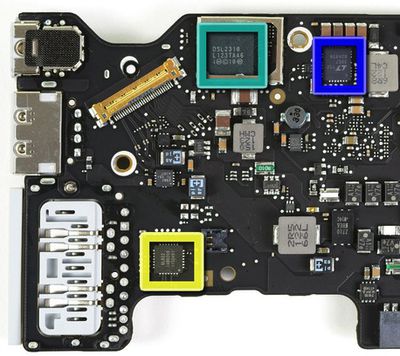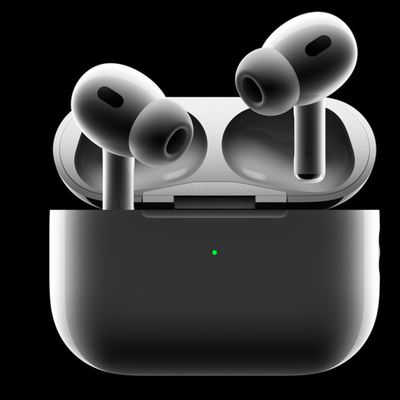New MacBook Air Using Scaled-Down Thunderbolt Chip
 Portion of MacBook Air motherboard with Eagle Ridge chip outlined in teal (Source: iFixit)
Portion of MacBook Air motherboard with Eagle Ridge chip outlined in teal (Source: iFixit) at the Thunderbolt controller used by Apple in the new MacBook Air, finding that the company has opted to use a scaled-down "Eagle Ridge" controller chip from Intel instead of the "Light Ridge" chip found in larger Thunderbolt-enabled machines.
[Light Ridge] features four Thunderbolt channels (4 x 10Gbps bidirectional = 80Gbps aggregate bandwidth) and up to two DisplayPort outputs. It's used in the 2011 iMac, MacBook Pro and Mac mini. ...
Eagle Ridge is available in two form factors (normal and SFF [small form factor]) and is effectively half of a Light Ridge chip. That means you only get two Thunderbolt channels and one DP output. Apple used the small form factor version of Eagle Ridge in its new MacBook Air to cut cost and save on motherboard real estate.
With Eagle Ridge only supporting a single DisplayPort output, MacBook Air users are only able to drive a single external display via the Thunderbolt port, although the machine's integrated Intel HD Graphics 3000 would also preclude the use of two external monitors on the MacBook Air as it does on the 13-inch MacBook Pro.
Thunderbolt adoption has thus far been limited to high-end devices in part due to high costs associated with inclusion of the technology. Use of the scaled-down Eagle Ridge controller could help push Thunderbolt into lower-end products, presuming that the smaller chip carries some cost savings for manufacturers.
Popular Stories
The long wait for an Apple Watch Ultra 3 appears to be nearly over, and it is rumored to feature both satellite connectivity and 5G support.
Apple Watch Ultra's existing Night Mode
In his latest Power On newsletter, Bloomberg's Mark Gurman said that the Apple Watch Ultra 3 is on track to launch this year with "significant" new features, including satellite connectivity, which would let you...
The iPhone 17 Pro Max will feature the biggest ever battery in an iPhone, according to the Weibo leaker known as "Instant Digital."
In a new post, the leaker listed the battery capacities of the iPhone 11 Pro Max through to the iPhone 16 Pro Max, and added that the iPhone 17 Pro Max will feature a battery capacity of 5,000mAh:
iPhone 11 Pro Max: 3,969mAh
iPhone 12 Pro Max: 3,687mAh...
The upcoming iPhone 17 Pro and iPhone 17 Pro Max are rumored to have a slightly different MagSafe magnet layout compared to existing iPhone models, and a leaked photo has offered a closer look at the supposed new design.
The leaker Majin Bu today shared a photo of alleged MagSafe magnet arrays for third-party iPhone 17 Pro cases. On existing iPhone models with MagSafe, the magnets form a...
iOS 26 and iPadOS 26 add a smaller yet useful Wi-Fi feature to iPhones and iPads.
As spotted by Creative Strategies analyst Max Weinbach, sign-in details for captive Wi-Fi networks are now synced across iPhones and iPads running iOS 26 and iPadOS 26. For example, while Weinbach was staying at a Hilton hotel, his iPhone prompted him to fill in Wi-Fi details from his iPad that was already...
Apple's position as the dominant force in the global true wireless stereo (TWS) earbud market is expected to continue through 2025, according to Counterpoint Research.
The forecast outlines a 3% year-over-year increase in global TWS unit shipments for 2025, signaling a transition from rapid growth to a more mature phase for the category. While Apple is set to remain the leading brand by...
Apple today seeded the second betas of upcoming iOS 18.6 and iPadOS 18.6 updates to public beta testers, with the betas coming just a day after Apple provided the betas to developers. Apple has also released a second beta of macOS Sequoia 15.6.
Testers who have signed up for beta updates through Apple's beta site can download iOS 18.6 and iPadOS 18.6 from the Settings app on a compatible...
AppleInsider's Marko Zivkovic today shared a list of alleged identifiers for future Mac models, which should roll out over the next year or so.
The report does not reveal anything too surprising, but it does serve as further evidence that Apple is seemingly working on new models of every Mac, including the MacBook Air, MacBook Pro, iMac, Mac mini, Mac Studio, and Mac Pro.
Apple is...




















